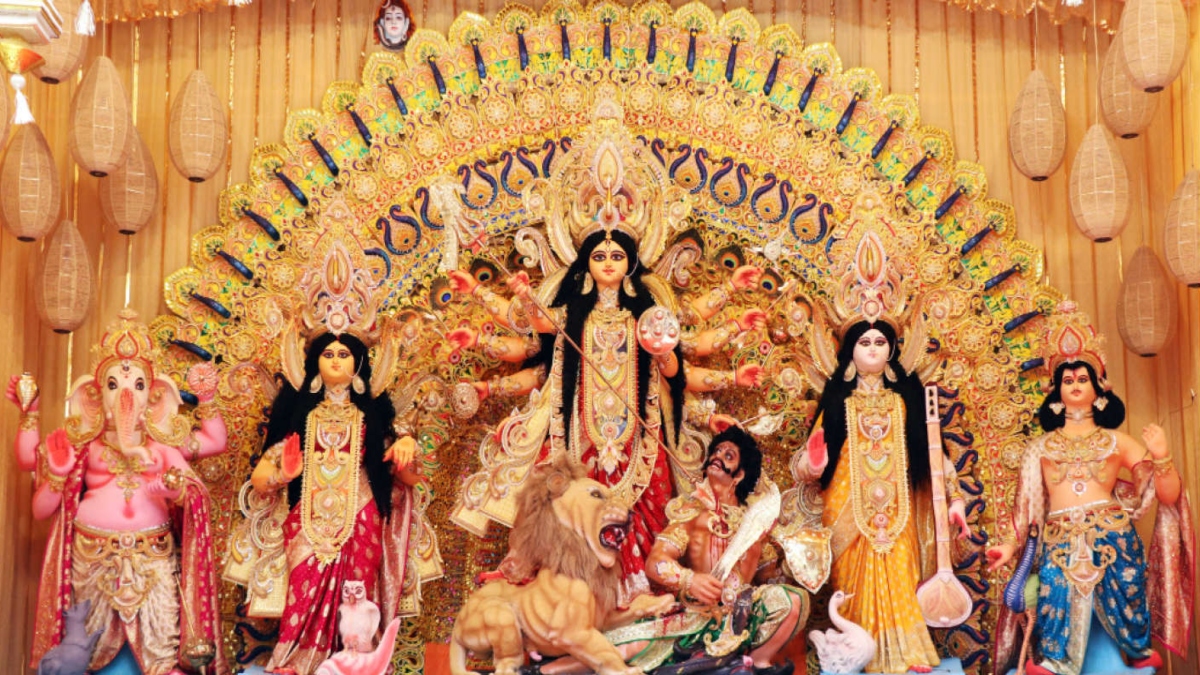Worship of the feminine principle or Sakti, also variously termed as the Devi, Matrikas or Mother Goddesses, is considered as the oldest religion in the history of human civilization, and the worshippers are known as Saktas. Here the Devi is not limited to being just a consort of a male devta (as Uma or Parvati in Shaivism, and Sridevi and Bhudevi in Vaishnavism), but here She is the one in focus as the main deity. This article will take a look at this worship of the feminine principle or Sakti from early human history, which wondrously still continues among the Hindu, Jain, and Buddhist communities.

Paleolithic burial in a foetal sleeping position.

Mother goddess from the Harappan culture c 2500 1900 BCE.


Venus of Willendorf, Naturhistorisches Museum Wien, 22000 to 24000 BCE, Upper Paleolithic.




GOING BACK IN HISTORY
In all ancient cultures or primitive societies women were seen as the foundation pillars upon whom rested the important tasks of giving birth and rearing the young, while teaching them what were seen as social norms, culture-heritage, behavioral habits, and traditions of those times. The women were seen as life producers with regenerative capacities, hence her organs that helped in procreation became the symbols of new life, and motherhood became the core figure in magic-religious cults of those times. The Paleolithic female figures found in abundance from various excavation sites with exaggerated maternal organs, stand as an evidence, showing the popularity of Mother Goddess worship in prehistoric times; a practice still popular in India, in a more developed form of worship of the Sakti or the feminine principle.
A regular supply of food and offspring would have been the most important requisites of the primitive society, thus one can assume that preservation of life would be at the core of any prehistoric religious cult. As a general norm it is seen that the way of life of a group of people tend to define the basic framework for the type of deity and manner of worship in that group. From hunter gatherers, as the primitive society moved towards food production or farming, the regular food (hunted or farmed) acquired a high degree of importance and sacredness, and the women’s capability of procreation soon got associated with the plants and animals that kept the society nourished in ancient times. Thus, the primitive mother goddess figures (from Middle and Upper Paleolithic times) that we see with grossly exaggerated sexual organs initially would have been part of some fertility rituals asking for greater production of game and human offspring. During the Neolithic times as the society slowly moved towards agriculture, the religious beliefs started adding agricultural rituals alongside the hunting ones that were already in practice. The graves found in the upper Paleolithic sites across the world held skeletal remains with bones that were reddened using ochre, along with food, tools, weapons, and ornaments. Red being the color of regeneration, and the foetal positions of the skeletons, tend to point to a Paleolithic belief that the soul or body would regenerate (a rudimentary concept of re-birth) and start a new life again. However, Neolithic graves show some changes and the visibly greater pomp and reverence in laying down the body under the earth, pointed at a changed belief where the body was believed to affect the crops that sprung forth from the Mother Earth. Thus, during the Neolithic times the Mother Goddess was not just a life-creating mother, she was also the Mother Earth from whom the crops sprung, and who like any other woman could also be influenced with gifts and entreaties, who would help when entreated with various rituals and rites. Across all later cultures spread across Egypt, Mediterranean, Syria, Iran, and parts of SE Europe, female figurines in bones, stones, or clay have been found that are said to be the direct descendants of the images of deities created by the older Mesopotamian, Syrian, and Greek societies.
LOOKING AT THE INDIAN SCENARIO
Paleolithic era of the Old Stone Age is correlated with food gathering or Hunting societies/economy; while Neolithic era roughly relates to the transition from food gathering to food producing societies, though the latter has no uniform time frame in terms of the economy. This is especially so in India, hence it is more logical to focus on the anthropological categorizations, which can be better identified and recorded from among the different surviving Indian tribes (many of whom were still following the prehistoric customs until very recently). From a study of the existing Indian tribes three main types that had been derived are hunting-food gatherers, pastoral, and agricultural. However, the three are not mutually exclusive, nor do they have any particular chronological order. So often, we find pastoral communities that practice agriculture along with stock raising, and agricultural communities that indulge in stock raising along with hunting. Regarding the rites and rituals followed by the food gatherers and agricultural societies, the worship of mother goddess was at the core of all their magic -religious beliefs. However, the pastorals had a very different way of living, and they endured greater hardships in their daily lives. The pastorals were more dependent on a good leadership to protect their cattle, and this in turn gave rise to the development of community heroes and ancestors, who were worshiped and highly revered by the members of this community. Since the pastorals spent a large time under the open skies and endured the wrath of the nature in form of storms, harsh sun, or heavy rains, their gods were inevitably connected to the sky, in which nature and astral objects were personified as gods. The Supreme God of the pastorals is thus a man who leads and protects them, much like the headman of a joint patriarchal family. On the other hand, agricultural societies who are dependent on the earth to produce their crops developed the worship of feminine energy and the cult of Mother Goddesses, which involved rituals related to fertility and magic.
MOTHER GODDESSES AND FERTILITY
The concept of Mother Goddess and associated fertility rituals is the most primitive and longest surviving religious practices in the world. The belief that women can multiply crops and fruits because they can create children out of their bodies was universal across all ancient societies. Thus, came the belief that what is sown or planted by a pregnant woman will also grow to bear fruits much like the child in her womb, while a barren woman will make the fields barren too. As per the prehistoric thinking, women, who were also the first cultivators, with their child bearing capabilities would create a similar effect on the earth’s vegetative powers leading to good harvests, and thus women were seen as repositories (storeroom) of agricultural magic. In prehistoric era people would apply their own experiences from life to the various things that they saw around them, which is now known as principle of analogy. Thus, natural productivity was compared to human procreation capability, and earth mother or the mother goddess was conceptualized from a human mother. There are innumerable such examples from old Indian literature. Almost all the Puranas and Smritis (law books for various sects) have the line Ksetra-bhuta smrta nari vijabutah smrtah puman, where kshetra (seed-field) refers to woman (woman is mentioned as a seed field also during the marriage ceremonial rites), and a man is identified as the seed. This likening of the woman to the field or earth means that the functions of the two are the same, with the belief that conditions that lead to a woman becoming fertilized applies also to the Earth. The same belief continues in the ritual known as ambuvaci (observed on and from 7th day of the third month of the Hindu calendar). It is believed that that during the four days of the ritual the Mother Earth also bleeds to prepare for fertilization. All kinds of agricultural work like ploughing, sowing etc, are suspended at this time so that Mother Earth can rest during her menstruation (also refer to the rituals of Kamakhya devi in Assam during ambuvaci).
The tantric form of worship also lays special importance to the menstrual blood for the same reason. Here in comes the use of the color red/vermilion, which we see being used in almost all Indic religious traditions. The Bhil tribes before sowing their fields followed the traditions of setting up of a stone smeared with vermilion. Since vermilion or red color symbolizes the menstrual blood, the smearing of vermilion implies the passing of the energy of procreation to the earth and making it fertile. The Mohenjodaro Mother Goddesses mostly have a red slip or wash paint over them, as are the Venus figures of Willendorf (Austria). Briffault who connected the red color with menstrual blood and fertility further said that in many countries across the world it was an ancient custom for women to color their bodies with red ochre in order to improve their chances of fertility. The same tradition is still seen in Hindu women who wear vermilion (sindur) after marriage, signaling their bindings to one man and the readiness to procreate, and it is for the same reason that widows and unmarried girls do not wear sindur. Holi, which is also a ritual of fertility, originally showed the profusion of color red.
In Tantric form of worship the focus remains on the rituals centering on the female genitals (lata sadhana), and the tantric yantras that symbolize female organs. During Durga puja a yantra known as sarvatobhadramandala symbolizing the female procreation organs is drawn on the ground in the form of alpona. Then a purnaghata or a purnakumbha symbolizing the womb is placed on it and sindurputtali or the figure of a baby is drawn on the ghata, and finally five leaves or amrapallava is placed on the ghata with a sindur-smeared coconut on top. Thus, this simple fertility ritual connects female regenerative powers of both humans and plants (human and natural fertility) to ensure continual procreation.
That the yantra and purnaaghata is associated with fertility is best depicted in the murti of a mother goddess found on the hilly slopes facing the river Krishna in Nagarjunakonda. It depicts the lower part of a female figure in a sitting or squatting position with legs doubled up and set wide apart and the feet facing outwards. The bifurcated part prominently shows the vulva or the yoni-dvara, and the ornamented broad belt or girdle (mekhala) from below the naval creates a purna-ghata like imagery. Satapatha Brahmana equates a purnaghata with the mother goddess while Kathasaritasagar is more detailed in its comparison of the purnaghata with that of a womb.
The concept of Mother Goddess worship is now lost (except perhaps surviving in token symbolisms) across the world, as religious orders broke down and changed over the course of human history. It however survives and thrives in India through its Sakti worship. This form of Devi worship, which started with the beginning of human civilization and still continues unbroken, is thus a joyous celebration of nature and womanhood that has the power to create new life, give birth, and keep the human species alive.
Disclaimer: Photos taken from the internet are for representation purposes only and have no commercial use.





















